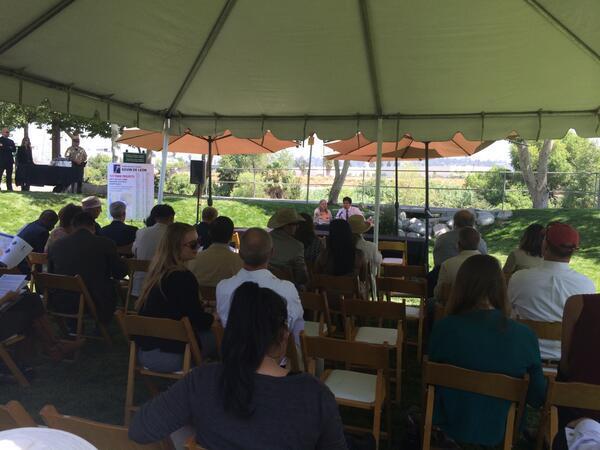Proposed Park Bond Will Help Pay for L.A. River Revitalization

Fresh from the city's victory in gaining a $1-billion support for the Los Angeles River revitalization, the community is now looking to find funding sources that could help the city and state fulfill its end of the bargain: 50 percent of that $1 billion price tag. A proposed park bond, the first since the 2002 Proposition 40 resources bond, which made $2.6 billion available to complete 1,888 projects, is being crafted by senators Kevin de Leon (D-Los Angeles) and Fran Pavley (D-Agora Hills).
The two senators held a Joint Informational Hearing of the Senate Committee on Natural Resources and Water and the Senate Subcommittee on Fiscal Oversight and Bonded Indebtedness at Marsh Park on the Los Angeles River. A group of about fifty people sat within the park's natural amphitheater, enjoying the cool breezes, relaxing greenery, and frequent sights of Angelenos making use of the Los Angeles River bikeway that runs alongside the park. The group convened to discuss and give recommendations for Senate Bill 1086, the Safe Neighborhood Parks, Rivers and Coastal Protection Bond Act.
More on L.A. River revitalization and development
Eleven experts gave testimony in front of the senators, giving recommendations on the structure of the future senate bill. Again and again, the call was to contextualize Los Angeles' role regionally, while involving the local agencies and communities in the process. "Respect indigenous peoples," said Joe Edmiston, executive director of the Santa Monica Mountains Conservancy. By that Edmiston meant that while implementing projects, local communities should feel they have a voice in the process. This would ideally happen by working with agencies that have a local presence, but have a regional focus. These aren't agencies that have headquarters in Sacramento, but people who actually live and work in the communities where these projects are planned.
In his testimony, historian William Deverell, chair at the University of Southern California's Department of History, took audiences down a page in L.A. history when the city missed an opportunity to implement urban planner Frederick Law Olmsted Jr.'s ambitious plan to connect the city's pocket parks, mountains and beaches, so that locals wouldn't be far from green space. Despite initial support, the sophisticated plan was eventually buried by the Los Angeles Chamber of Commerce, who did not care for the possibility of creating superjurisdictional body to oversee development in the city. Doing so would effectively hobble the powers of the Chamber of Commerce, "probably the most powerful commercial body of its kind in the American West, if not in the nation."
Though never implemented, piecemeal projects have gone on to be realized in the Los Angeles River Revitalization Master plan and then hailed as discrete successes by the city. The city shouldn't settle for these comparatively small successes, said Deverell. Instead, "we can work on the piecemeal, but can we fit it into a larger whole that can only do good for the whole of Los Angeles?" In short, we should celebrate the city's L.A. river successes, but parlay those breakthroughs into a larger triumph.
Rather than the scattered governance of the Los Angeles River, Sean B. Hecht, co-executive director of Emmett Institute on Climate Change and the Environment at UCLA Law School, had also suggested reviving the idea of a joint powers body to consolidate river management. Right now, Los Angeles has a Los Angeles River Cooperation Committee that talks about projects and makes decisions that aren't binding. As Hecht points out, right now, Los Angeles has an "odd patchwork of governance," but Los Angeles needs "to think and plan more strategically."
Matt Peterson, the mayor's Chief Sustainability Officer, also posed a question: "How can this park bond be a solution for drought?" California has the potential to green itself through this bond, but can it concurrently offer more benefits to its community than just aesthetic? Though Los Angeles is safe from most storms, its major concern is earthquakes. Can recreational centers in parks also double as evacuation centers in times of emergency?
Finally, Robert Garcia of the City Project reminds the senators that this pure park bond should be distributed fairly, to provide access for communities regardless of their wealth or legal status. Garcia cited the success of Assembly Bill 31, the Community and Neighborhood Park Revitalization Act introduced by de Leon in 2008, for which City Project helped craft standards of what it meant to be park poor and income poor. "[AB 31] is working," said Garcia. Through AB 31, 58% of funds went to communities that were park and income poor; 35% went to communities that were either park poor or income poor. The City Project has analyzed the $400-million fund from AB31, but no such measures were introduced in Prop 84's $5.4 billion pot of money. Garcia says oversight such as this should be part of any bond measure. "Fair distribution of funds is good policy."





